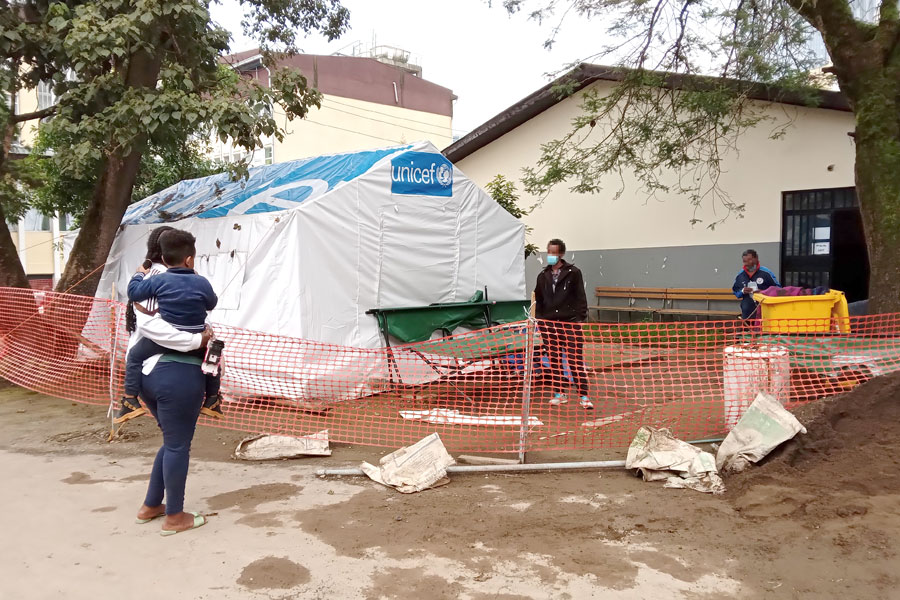
Commentaries | Jun 07,2020
Apr 25 , 2020
By Muluneh Yigzaw
Significant shifts in resources to fight pandemics limit the ability to provide other essential health services. Such precarious conditions are more significant in low-income countries such as Ethiopia where health systems are not resilient enough to absorb shocks, writes Muluneh Yigzaw (PhD) (yigzawm@gmail.com).
Since the first cluster of cases was identified in Wuhan, China, in December 2019, the Novel Coronavirus (COVID-19) has spread to almost all countries in the world. The World Health Organization (WHO) declared it "a public health emergency of international concern" on January 30, 2020.
Ethiopia reported the first case of COVID-19 on March 13, 2020. Since then the number of cases has steadily increased to 111 cases reported in just five weeks.
The Ministry of Health and its partners are now in full force to curb the pandemic. The country has closed inland travel across its borders, and travellers that come by air to Ethiopia from abroad have been required to remain in isolation for 14 days. Quarantine and treatment centres have been established, and diagnostic kits have been distributed to regional and university laboratories. A national state of emergency has also been declared.
While fighting pandemics of this scale, the damage inflicted by other health threats is often overlooked. Significant shifts in resources to fight pandemics halt our ability to provide other essential health services. Such precarious conditions are more significant in low-income countries where health systems are not resilient enough to absorb shocks. When a pandemic of such magnitude occurs, there is also widespread stigmatisation and abandonment of hospitals as people perceive these facilities to be favourable breeding places for the disease.
Stigmatisation and abandonment of healthcare facilities is further exacerbated by misinformation and blunted health communication strategies. In countries such as Ethiopia, where the level of health literacy is low, people will certainly be influenced by unfounded claims.
The notion that healthcare facilities are breeding places for contagious diseases is not an unsubstantiated public concern. Unless standard procedures are followed, hospitals and health centres can become sources of new infections. Yet if healthcare workers follow standard precautions, these facilities will be safe to visit and receive essential health services without concern.
COVID-19 has already killed over 100,000 people across the world. These are deaths directly caused by this contagious disease. Surges in deaths from other causes is eminent because of health system disruptions. Yet health officials have barely tallied these indirect deaths. We are in the black box, and nobody knows the scale of deaths as a result of health system disruptions.
Past epidemics have shown the true effects of health system disruptions. The negative effects of large-scale epidemics on health systems were explicitly seen during the Ebola Virus Disease (EVD) epidemic in West Africa from 2013 to 2016. Apart from the direct deaths caused by the epidemic, EVD weakened health systems and ultimately resulted in many deaths among mothers and children under five years old.
There is mounting evidence that healthcare facilities were overwhelmed by EVD cases and were unable to manage other health conditions at that time. Individuals and communities lost confidence in the healthcare system and even considered it a potential place of viral spread. As a result, people were hesitant to receive care from hospitals.
Women gave birth in their homes without a skilled birth attendant. Child deaths surged because of lack of treatment for common childhood diseases. Immunisation programmes ceased, and malaria deaths climbed, because the quick diagnosis and treatment of severe cases was limited.
The health system in Ethiopia has already started feeling the effects of COVID-19 within this short period. The number of blood donations has, for instance, significantly dwindled. It has been reported that the number of clients seen by healthcare facilities has woefully been dropping since the illness was first reported in the country.
There have also been rumours that labour and childbirth have taken place at home without a skilled birth attendant, as women and their families fear Coronavirus infections in healthcare facilities. Many people with an illness stay at home, facing possible complications and death.
As the COVD-19 cases are surging, Ethiopia’s government should chart a coherent path and exert an all-out effort to combat the pandemic. Side by side with this response, a proper epidemic intelligence organisation should be put in place to monitor other lethal epidemics, since Ethiopia is vulnerable to multiple illnesses that have the potential to start pandemics.
Malaria outbreaks are often seasonal and inflict significant damage during autumn and spring, the harvesting seasons in rural Ethiopia. When outbreaks occur in non-endemic fringe areas, Malaria fatality is significantly higher and far more fatal than COVID-19.
Another worry is Measles. Unless almost all children are vaccinated, it can occur in an epidemic form and kill a significant number of children. Measles is an extremely contagious disease. Every case results in an average of 12 to 18 new cases, making it far more contagious than COVID-19.
Unless mitigation measures are in place, diseases such as these could create a human tragedy that reverses our health gains over the past two decades.
The public should be reassured that healthcare facilities are still safe and are not serving as breeding places for COVID-19. The Ministry of Health should remain vigilant and take a series of measures to restore public confidence.
The first one should be doubling down on efforts to slow the spread of COVID-19. When its spread slows down, healthcare facilities will not be overwhelmed by multiple COVID-19 cases at a time, and there will not be health system disruptions.
Another measure is stringent oversight to prevent the spread of the virus inside the premises of healthcare facilities. This should be followed by the establishment of a public relations system to communicate and reassure the public to remain confident in healthcare facilities. It should also be ensured that the quality of service remain optimal and address the needs of individuals and families.
Women should be encouraged to give birth in healthcare facilities as they did before the pandemic. Childcare clinics should open their doors all days of the week as they used to. A disease surveillance system should be activated to identify any outbreak in its early stage, before it causes significant causalities.
We should not give this scourge the chance to spoil our health system and reverse our achievements over the past two decades.
PUBLISHED ON
Apr 25,2020 [ VOL
21 , NO
1043]


Commentaries | Jun 07,2020

Radar | Jan 07,2022

Radar | Apr 02,2022

Radar | Oct 17,2020

Fortune News | Aug 05,2023

Radar | Feb 06,2021

Commentaries | May 18,2019

Radar |

Viewpoints | May 31,2020

Fortune News | Feb 16,2019

My Opinion | 131981 Views | Aug 14,2021

My Opinion | 128369 Views | Aug 21,2021

My Opinion | 126307 Views | Sep 10,2021

My Opinion | 123925 Views | Aug 07,2021

Dec 22 , 2024 . By TIZITA SHEWAFERAW
Charged with transforming colossal state-owned enterprises into modern and competitiv...

Aug 18 , 2024 . By AKSAH ITALO
Although predictable Yonas Zerihun's job in the ride-hailing service is not immune to...

Jul 28 , 2024 . By TIZITA SHEWAFERAW
Unhabitual, perhaps too many, Samuel Gebreyohannes, 38, used to occasionally enjoy a couple of beers at breakfast. However, he recently swit...

Jul 13 , 2024 . By AKSAH ITALO
Investors who rely on tractors, trucks, and field vehicles for commuting, transporting commodities, and f...

Jul 5 , 2025
Six years ago, Ethiopia was the darling of international liberal commentators. A year...

Jun 28 , 2025
Meseret Damtie, the assertive auditor general, has never been shy about naming names...

Jun 21 , 2025
A well-worn adage says, “Budget is not destiny, but it is direction.” Examining t...

Jun 14 , 2025
Yet again, the Horn of Africa is bracing for trouble. A region already frayed by wars...

Jul 6 , 2025 . By BEZAWIT HULUAGER
The federal legislature gave Prime Minister Abiy Ahmed (PhD) what he wanted: a 1.9 tr...

Jul 6 , 2025 . By YITBAREK GETACHEW
In a city rising skyward at breakneck speed, a reckoning has arrived. Authorities in...

Jul 6 , 2025 . By NAHOM AYELE
A landmark directive from the Ministry of Finance signals a paradigm shift in the cou...

Jul 6 , 2025 . By NAHOM AYELE
Awash Bank has announced plans to establish a dedicated investment banking subsidiary...